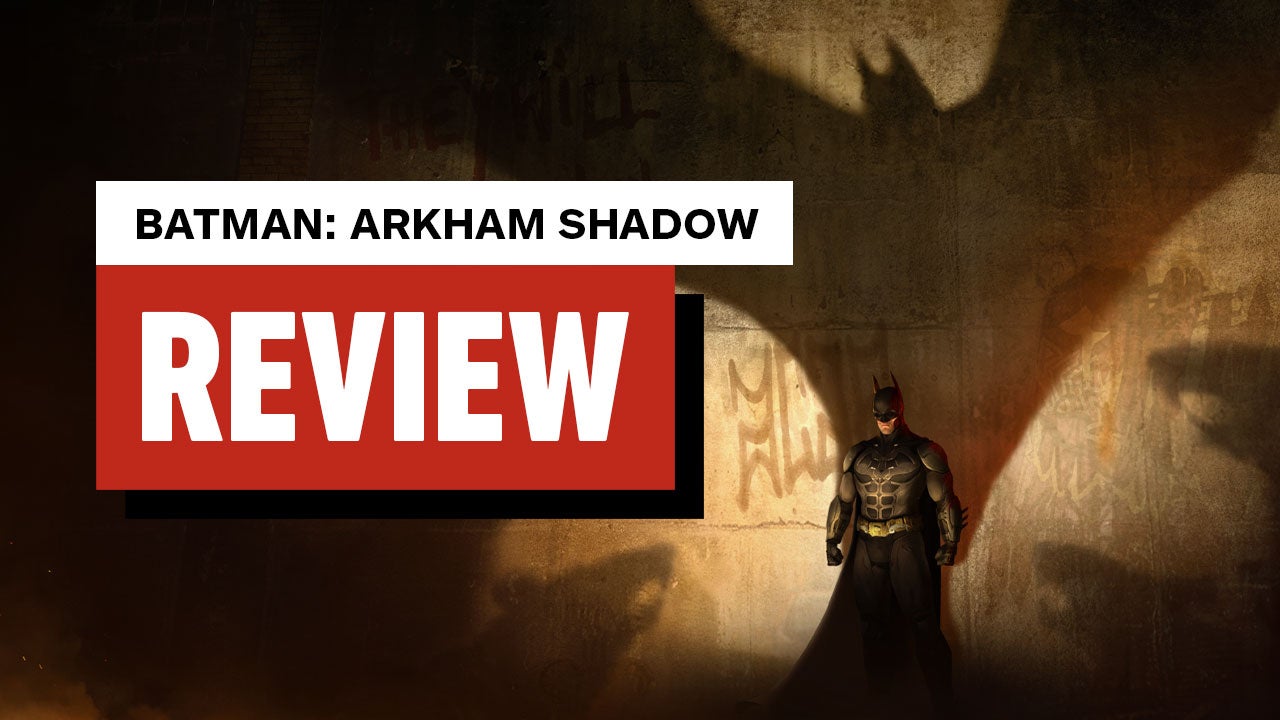It’s difficult to realize that almost ten years have passed since the last Batman Arkham mainstream game. Since then, a number of initiatives that are close to Arkham have been launched, but they have felt constrained or fall short in some other way. Batman Arkham VR from 2016 was a nice tech demonstration, but it only covered the investigative aspects of the series. Batman-themed cooperative games were released in recent years by both Rocksteady and WB Montreal, two established Arkham companies, but both failed for a variety of sometimes related reasons. Batman: Arkham Shadow is the best Batman game since Arkham Knight, even if it doesn’t reach the same heights as the series’ best moments. It does this by faithfully recapturing the essence of the Arkham series in ways that other recent Batmanverse games disappointingly and purposefully avoided.
Batman
Arkham Shadow is a direct sequel to Arkham Origins that takes place around a year later and is only available in virtual reality. This indicates that this Batman, who is once more portrayed by Roger Craig Smith in a strong Kevin Conroy impersonation, is still a bit unproven and nerdy. His amazing ability to stay ten steps ahead of his opponents isn’t assured, and his temper can still get the better of him as he learns to become the unflappable Batman that we usually know him to be. First-person gameplay is used to explore several contained areas of Gotham before spending the majority of the game in Blackgate Prison. This gives the game a framework that is strikingly similar to the 2009 film Arkham Asylum’s metroidvania architecture.
The Rat King
The Rat King, a new foe in Batman mythology, is believed to be hiding out in the prison a few days before his devastating attack on Gotham takes place. The Dark Knight’s task is to find and stop him. Instead of following Arkham’s typical nightly plot structure, Shadow’s story is told over the length of an in-game week, and occasionally it shows.
About half of the game is spent out of costume, posing as Irving “Matches” Malone, an inmate who grants you access to the high-security jail. Some of the game’s pacing isn’t consistent with what Arkham games typically give. For example, paying money in the commissary to purchase cosmetics to adorn your prison cell is a throwaway feature, but the selection is too limited and unattractive. However, even these cool alternatives would have felt like an inappropriate addition to the Arkhamverse.
Game Overview
Whether he’s dressed as a superhero or an inmate, Batman doesn’t hang out, so you’ll only actually see his cell at the end of the day. But when you’re not wearing the cowl, it’s more than just conversation. While playing as Matches, there are still some fun moments, like as tasks that require you to sneak about the facility or engage in combat with other prisoners outside of Batman’s typical repertory, but they are nothing compared to the memorable experience in Kevlar.
Regardless of Bruce Wayne’s attire, I kept coming back to the same problem: there aren’t many noteworthy villains. The game has very few boss fights, and the majority of them don’t include any of Batman’s main villains. Most of the time while I played Arkham Origins, I couldn’t help but feel that I was facing off against Batman’s B- and C-tier adversaries. No pun meant, but Firefly is nothing compared to Joker, Two-Face, or Poison Ivy.
Arkham By replacing someone like Origins’ Deathstroke with Lock-Up, a massive Tyger guard who finds it difficult to feel like anything more than a boosted-up common enemy, Shadow reduces the amount of theatrics even further. Shadow, to its credit, also capitalizes on the fact that its plot takes place early in Batman’s career, allowing you to spend a lot of time with people whose storylines fans are all too familiar with, but you’ll see them before they’ve fallen into their own abysses. That’s typical prequel fodder, but I like it when it’s done well in the Batman universe, which is what it is here—in a few instances, but one in particular.
Game Storyline
Arkham Shadow falls short of Rocksteady’s best work in terms of plot merit. The bar is really high because I’ve always thought of Arkham City as one of the best Batman stories ever, regardless of medium. While Arkham Shadow doesn’t live up to the high standards, it’s still a good story. It has some excellent character moments and improves in the last act. Because it uses the same art direction and an original soundtrack that sounds similar, it faithfully evokes the atmosphere of the other games. Arkham Shadow wants you to feel that it deserves to be in the same place in your mind as the earlier games in the series, and it wants you to remember those times with nostalgia. And practically everything else does, even if a tale doesn’t.
Arkham Shadow is only available on the Meta Quest 3 (and its less expensive, marginally weaker twin, the Meta Quest 3S), as well as virtual reality as a platform. However, it functions as a fundamental component of the highly acclaimed series in every way that viewers would find significant. The fighting, stealth, and detective aspects of the series’ gameplay loop are all carried over in Arkham Shadow, unlike Arkham VR.
The best indication that Shadow functions as a legitimate Batman game is the combat. It would be a stunning display for a Batman fan who is dubious about virtual reality or even for someone who has never tried it. With its trademark counter mechanisms that are perfectly translated into virtual reality, it delivers the same blend of fluidity and complexity as previous games, enabling you to defeat a dozen villains without even scratching your bare chin.
When the on-screen prompt arrives, Shadow displays the same lightning bolt-like symbol on the left or right side of your interface, and you can execute the move by just throwing your arm out to the same side instead of pressing a face button to activate the counter. Similar to past Arkham games, you may easily interrupt your own attack to use a counter that keeps your combo meter going, unlocking items like finishing moves and using Batman’s shock gloves. Crucially, the camera automatically moves to show you facing countered enemies, but you may also turn on your own. It all feels as smooth as the series’ current games and is deserving of the term “freeflow” on its own.
Game Characters
You may recognize some of the foes from the series, and they all contribute to the intricacy of the battle. Your cape must stun a larger, more vicious Tyger guard. To do this in virtual reality, make a hook motion with your arm without holding the triggers, which would translate as a punch or fist. The right stick is used to scale and over enemies wielding stun batons, and both arms are raised and thrown down to kick them in the back. Knife-wielding individuals must be avoided by ducking before you can retaliate with your own blows, and riot-shielders require a combination of climbing and cape-stunned maneuvers before to an overhead forearm smash.
These will sound familiar to Arkham veterans because they are precisely the same as what you would do in the prior games, and the physics of it all feel exactly like I remember it feeling, in a way that I cannot technically articulate. You automatically get a tidal surge of dopamine since every combat engagement is thrilling and manageable enough to allow for mastery of its systems. I am Batman in a way I have never been before.
When navigating the world in all the ways you can as the hero, this is as uncannily true. You travel at the same pace and with what appear to be the same animations as in earlier Arkham games when you glide down from gargoyles or bat-claw over a cliff.
Instead of pressing a single button, you will physically extend both arms to your sides in order to execute a glide, but the overall sensation and appearance are the same. From 40 feet away, a gliding kick has the same appearance and feel that series experts are accustomed to. Batman seemed to move in the same manner that he did throughout the series, even glancing down at my legs while I was just moving.
Performing stealth activities is a more tactile, multi-step procedure, even though fighting in virtual reality involves roughly the same number of button clicks as it does on a gamepad. In an earlier Arkham game, you would press one button from a perch to jump on an adversary below and line them up like a warning flag to other players during “predator” sections. That single ability is executed in VR with a number of smaller motions: Holding down the right stick to hang from the gargoyle first, you then use both arms to lunge at an adversary in close proximity, lifting him up in the process. Like The Undertaker throwing Mankind from the cell in 1998, you tie them automatically, but then throw them away to finish the move.
Conclusion
It’s really not as complicated as it sounds. It quickly becomes second nature thanks to the on-screen instructions, and no move requires exacting precision. It accepts something that is sufficiently similar to what it is requesting, as is the case with most VR games. It’s also tactile to crouch behind adversaries or emerge from grates underneath them to silently choke them out. This requires you to thrust your arms forward and then toss them side to side a few times to mimic a chokehold until they faint.








